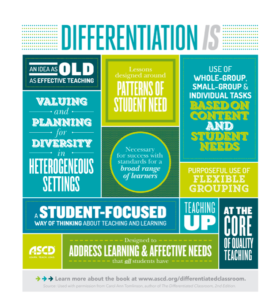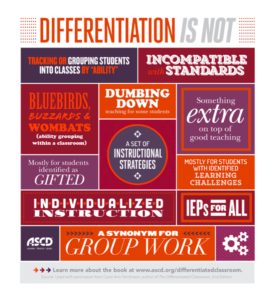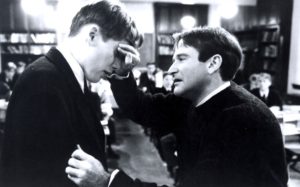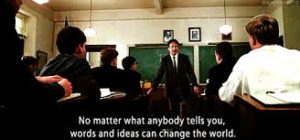Some high school students feel neglected when it comes to writing and may not receive any specialized writing instruction at all. Yet, the foundation of high school English education can be integral in supporting future writers. I argue we can use The UCWbL core practice “Adopt & Adapt Specific Strategies For Each Particular Writer & Their Particular Writing Context” within education to address this problem.
In considering accommodations for particular learners, teachers use this thing called differentiated instruction. This is basically a fancy term for making specific learning modifications to address patterns of student need, while simultaneously ensuring these modifications can be used for a broad range of learners. Conclusions about how to teach are based upon patterns that emerge from the students themselves.
Differentiated Instruction: Making Informed Teacher Decisions
In the article “Differentiated Instruction: Making Informed Teacher Decisions,” teachers in Maryland test the effectiveness of this theory by utilizing small group reading instruction for half of a 3rd grade class and teaching the rest of the class altogether. The results demonstrated differentiated instruction was much more beneficial, as each student felt recognized as an individual.
If tutors adapt their methods for each writer they work with at The UCWbL, considering what writers need in conjunction with how to plan their agenda, the outcome will be more productive than if they had planned with a more generalizing mindset with an imaginary writer in mind.
“It is understood that children bring to school an array of valuable cultural and linguistic experiences that may be similar or dissimilar to those of the teacher or other children in the classroom” (305).
Integrating Writing with Full Inclusion
In “Integrating Writing with Full Inclusion,” a teacher discusses asking individual students what they need from the classroom, instead of the other way around, promoting inclusion and respect for every learner. When thinking about “every learner,” consider not only ranges of strengths and interests across students but also students with special needs or learning disabilities.
I use this daily in my placement at Schurz High School on Chicago’s West Side where 75% of my students are bilingual and/or ELL students. Because of these circumstances, teachers make sure to use content that is relevant and language that is kind.
“Students inform me of their individual strengths and weaknesses, set goals, and devise individual edit checklists. Most of the evaluation is done through peer and teacher interaction as students read one another’s work” (406).
Writers with specific needs enter The Writing Center daily. A large group of students we work with regularly that share specific needs is ELLs. Incorporating these skills can be another form of support as tutors work with ELLs on their writing and language.
Connections Between Adolescence & Literacy Curriculum
As the article “Connections Between Adolescence & Literacy Curriculum” addresses, student age matters in a high school classroom. In this piece, teachers receive a gentle reminder that teenagers need support rather than being seen as ignorant or incapable. When adolescents are understood and encouraged as vehicles for change, they achieve more and look positively towards their educational future.
“How adolescence is understood significantly affects the ways young people are advocated for/with, intervened on behalf of, and organized and taught in schools” (398).
Writers of a range of ages enter The Writing Center, and tutors must remember that their writers are also their peers. Taking this into consideration allows them to see what kinds of support a particular writer may need based on the age they decide to attend college and the potential stigma surrounding it.
Writing as Relationship
In “Writing as Relationship,” there is a direct connection between writing and education. Teachers attempt to avoid grading-based language (what UCWbL tutors might understand as evaluative language), use culturally aware texts, and promote emotional writing. Instead of making the discipline entirely academic, students are encouraged to use their own personal insights and feelings to produce quality and authentic writing.
Ideas like differentiated instruction have been traced back in print to 1953, but methods are continuously modified based on the time period we live in and the demographics of a particular classroom. There is no one way to implement it, as there is no one kind of high school student.
UCWbL tutors might find value in the above ideas in order to:
- Listen to writers’ specific needs and plan tutoring agendas with mindfulness
- Adapt methods based on the kind of learner they are presented with
- Consider the assignment, the course, and the academic history of the writer they are working with for greater success
- Practice patience and understanding as they collaborate with a peer






